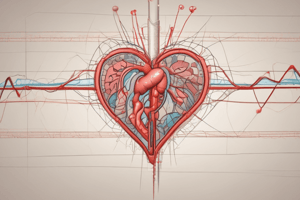Podcast
Questions and Answers
What is the primary purpose of an electrocardiogram (ECG)?
What is the primary purpose of an electrocardiogram (ECG)?
- To measure blood pressure
- To record the electrical activity of the heart (correct)
- To analyze brain waves
- To assess lung function
Which of the following is NOT a type of ECG lead?
Which of the following is NOT a type of ECG lead?
- Bipolar chest lead (correct)
- Unipolar limb lead
- Unipolar chest lead
- Bipolar limb lead
Which of the following ECG leads is used to measure the electrical activity between the right arm and left arm?
Which of the following ECG leads is used to measure the electrical activity between the right arm and left arm?
- Lead I (correct)
- aVR
- Lead III
- Lead II
What is the primary purpose of developing a systematic approach to ECG interpretation?
What is the primary purpose of developing a systematic approach to ECG interpretation?
Which of the following ECG waves represents the depolarization of the ventricles?
Which of the following ECG waves represents the depolarization of the ventricles?
What is the primary purpose of calculating the heart rate from an ECG tracing?
What is the primary purpose of calculating the heart rate from an ECG tracing?
Which limb leads record the electric changes between the right arm and left leg?
Which limb leads record the electric changes between the right arm and left leg?
According to Einthoven's Law, what is the relationship between Voltage in lead II, Voltage in lead I, and Voltage in lead III?
According to Einthoven's Law, what is the relationship between Voltage in lead II, Voltage in lead I, and Voltage in lead III?
Which chest lead is positioned at the left 5th intercostal space anterior axillary line?
Which chest lead is positioned at the left 5th intercostal space anterior axillary line?
In an ECG, where is the P wave usually located?
In an ECG, where is the P wave usually located?
Which Augmented Limb Lead records the electric changes from the right arm?
Which Augmented Limb Lead records the electric changes from the right arm?
What does Lead III in unipolar recording represent?
What does Lead III in unipolar recording represent?
What is the main cause of the QRS complex in an ECG wave?
What is the main cause of the QRS complex in an ECG wave?
Which part of the left ventricle does the S wave represent in an ECG wave?
Which part of the left ventricle does the S wave represent in an ECG wave?
What is the voltage range of the T wave in Lead II of an ECG?
What is the voltage range of the T wave in Lead II of an ECG?
Which of the following is masked by the QRS complex in an ECG wave?
Which of the following is masked by the QRS complex in an ECG wave?
What does the U wave in an ECG wave represent?
What does the U wave in an ECG wave represent?
Which part of the heart does the Q wave represent in an ECG wave?
Which part of the heart does the Q wave represent in an ECG wave?
What is the normal range for the P-R interval?
What is the normal range for the P-R interval?
What is the definition of sinus bradycardia?
What is the definition of sinus bradycardia?
What is the normal range for the electrical axis of the heart?
What is the normal range for the electrical axis of the heart?
Which of the following conditions can cause right axis deviation?
Which of the following conditions can cause right axis deviation?
What is the primary clinical significance of an electrocardiogram (ECG)?
What is the primary clinical significance of an electrocardiogram (ECG)?
Which of the following is NOT a component of a systematic approach to ECG interpretation?
Which of the following is NOT a component of a systematic approach to ECG interpretation?
What is the significance of the P-R interval?
What is the significance of the P-R interval?
Which of the following conditions can cause left axis deviation?
Which of the following conditions can cause left axis deviation?
What is the definition of a regular rhythm on an ECG?
What is the definition of a regular rhythm on an ECG?
Flashcards are hidden until you start studying




